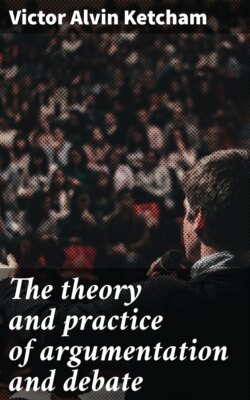Читать книгу The theory and practice of argumentation and debate - Victor Alvin Ketcham - Страница 3
На сайте Литреса книга снята с продажи.
PREFACE
ОглавлениеTable of Contents
The object of this book is to furnish practical directions for the preparation and presentation of oral and written arguments. Teachers of Argumentation and Debate have come to realize that interest can best be stimulated and practical results best secured by omitting the theoretical forms of reasoning at first, and leading the student directly to the actual work of building up an argument. The technical name of a logical process has little to do with its practical application. This fact is well illustrated by the constant use of arguments in our conversation: moreover, the student who enters upon this work is sufficiently advanced to appreciate the difference between truth and error. For these reasons the book is divided into two parts, the first of which deals with the Practice of Argumentation and Debate. After the student has had some experience in constructing and presenting arguments he is better fitted to make practical application of the theoretical principles of argumentation which are presented in the second part of this book under the head of the Theory of Argumentation and Debate. Those teachers who prefer to follow the old order of presentation can do so by taking up the Theory of Argumentation and Debate after completing the chapter on Collecting Evidence and before taking up the chapter on Constructing the Brief.
Since Argumentation and Debate has come to be a regular course of study in almost every college and university and in many of our larger preparatory and high schools, there has been a tendency among text-book writers to multiply rules regarding every phase of the subject. By consulting various works it will be found that no less than sixteen different rules have been formulated for the construction of the brief alone. One book contains as many as thirteen of these. To the average student the result is confusion rather than enlightenment. One of the objects of the author has been to remedy this condition of affairs by attempting to state clear-cut rules, which, though covering all contingencies, are limited to what is essential and practical. In regard to illustrations and examples the same idea has been carried out.
The order in which the subjects are discussed is that dictated by actual practice. The object has been to lead the student step by step, to point out all the difficulties along the way, and to show by precept and example how they may be overcome. After the essential definitions are given and the importance of the subject upon which he is entering is set forth, the student is shown where to find, and how to choose and express, a proposition for argument. He is then directed how to analyze that proposition for the purpose of finding out what he must do in order to establish its truth or falsity. Next, he is informed of the sources of evidence bearing upon the proposition, and how such evidence is to be collected and used. Directions for constructing a brief out of this evidence are then presented and the way in which the finished argument is to be developed is set forth. The psychological development of an argument is here for the first time given full consideration. Following this the student is shown how to defend his own argument and overthrow that of his opponent. Finally, instructions are given for delivering the argument in the most effective manner. Even without the aid of an instructor the student could follow the argumentative process through to the end.
The exercises given are intended to be practical and to assure a thorough working knowledge of the discussion. The material in the appendix may be used at the discretion of the instructor. The prevalence of references to the Lincoln-Douglas Debates is intentional and arises from the fact that the circumstances under which these debates occurred, the personalities of the participants, and the argumentative excellence of the discussions make them especially useful to the student.
The writer wishes to acknowledge his indebtedness to all those who have heretofore written upon this subject as well as to the students whom it has been his pleasure to instruct. He wishes especially to acknowledge the assistance of Professor Raymond M. Alden, who gave a careful reading to the greater part of the manuscript and made many helpful suggestions.
VICTOR ALVIN KETCHAM.
Columbus, Ohio, February 1, 1914.
